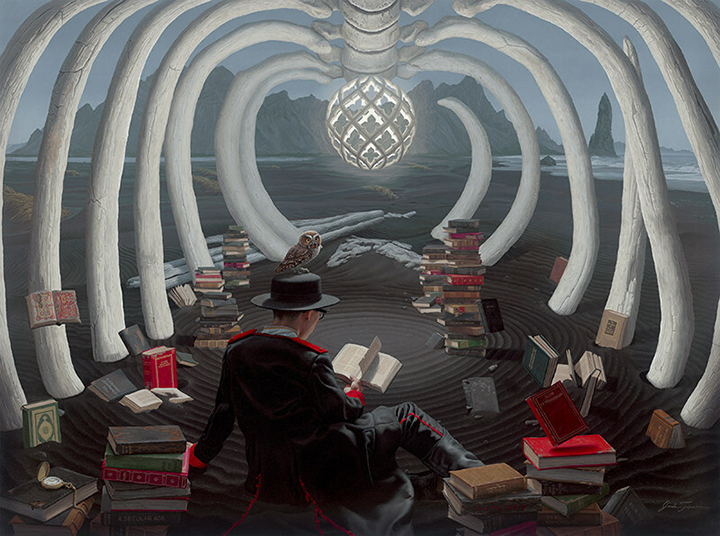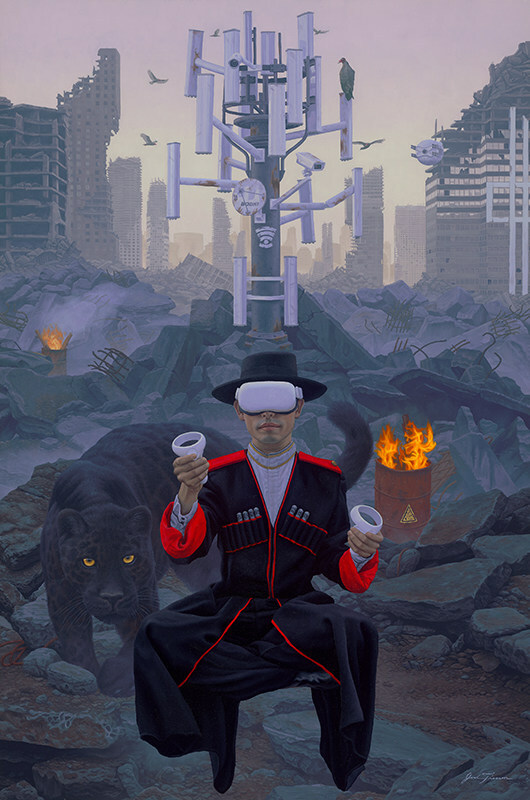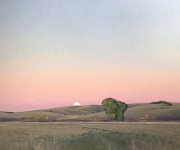This Spring, New York gallery Rehs Contemporary will present the newest body of work from Josh Tiessen – Vanitas and Viriditas. On view from April 28th through May 26th, the exhibition will be comprised of 23 meticulously crafted paintings and drawings, which required more than 5,000 hours of studio work over the course of three years!

Swallowed by Knowledge. Oil on Braced Baltic Birch, 30″ x 40″ x 2″. Photos – courtesy of Rehs Contemporary ©
Tiessen is an international award-winning artist based in Canada, best known for his hyper-surreal and uniquely shaped oil paintings. His pieces often delve into the interaction between the natural world and humanity, drawing on his studies in philosophy and theology. Continuing on that, Vanitas and Viriditas is an exploration of two divergent perspectives on wisdom and how we might flourish in a modern society filled with facts but mired in confusion.
Tiessen’s Vanitas paintings include a figure named Qohelet (Hebrew for “Teacher”). Inspired by the Jewish wisdom book of Ecclesiastes, these works represent the vanity of humans striving for power, wealth, and knowledge, often at the expense of the earth. The art historical vanitas genre, popularized by 17th-century Dutch still life painters, is based on the refrain in Ecclesiastes, “Vanity of vanities, all is vanity.” These images often included motifs such as skulls, moths, and ephemera to remind viewers of the temporality of life and the inevitability of death. Similarly in Tiessen’s works, Qohelet seeks to deconstruct all the ways in which we find meaning and purpose in life that inescapably let us down. He chases after modern idols of science, technology, material consumption, and pleasure, ultimately finding them wanting. Is it all just smoke and mirrors? Is there wisdom in being at peace with the endless paradoxes, or is it cause for despair? The philosophy behind the Vanitas paintings is visually symbolized through an achromatic colour palette, Japanese Zen rock gardens, and barren nihilistic landscapes.
The Viriditas paintings are built around a figure named Sophia (Greek for “wisdom”), inspired by the female personification of wisdom from the book of Proverbs. These works espouse virtues such as simplicity, humility, wonder, and awe, which are vital for cultivating ecological wisdom. The 12th-century nature mystic Hildegard von Bingen informed the character development of Sophia, from whom the Latin expression viriditas (translated as “holy greening”) originates. Sophia lives in a harmonious relationship with the natural world, attuning herself to the seasonal rhythms of nature. The vernal colour palette in these paintings is bright and cheery—emerald, sienna, yellow, and amethyst, accompanied by Celtic and Gothic Revival aesthetics.
Both Qohelet and Sophia are complemented by animal companions. Qohelet is disenchanted with the natural world and ambivalent toward his fellow creatures since ‘there is nothing new under the sun’. Sophia seeks to learn from the symphony of creation, heeding the advice of the ancient sage named Job:
“But ask the animals, and they will teach you,
the birds of the air, and they will tell you;
ask the plants of the earth, and they will teach you,
and the fish of the sea will declare to you.
Who among all these does not know
that the hand of the Lord has done this?
In his hand is the life of every living thing
and the breath of every human being.”
For Qohelet, wisdom is pursued with “fear and trembling,” accepting the sobering truth that everything in this world is fleeting. For Sophia, the path to wisdom is re-enchantment with the earth and its Creator, manifested in embodied skilful living. The original meaning of the word philosophy – “love of wisdom” is thereby restored. Flourishing can occur when we align ourselves with the wise grain of the universe.







